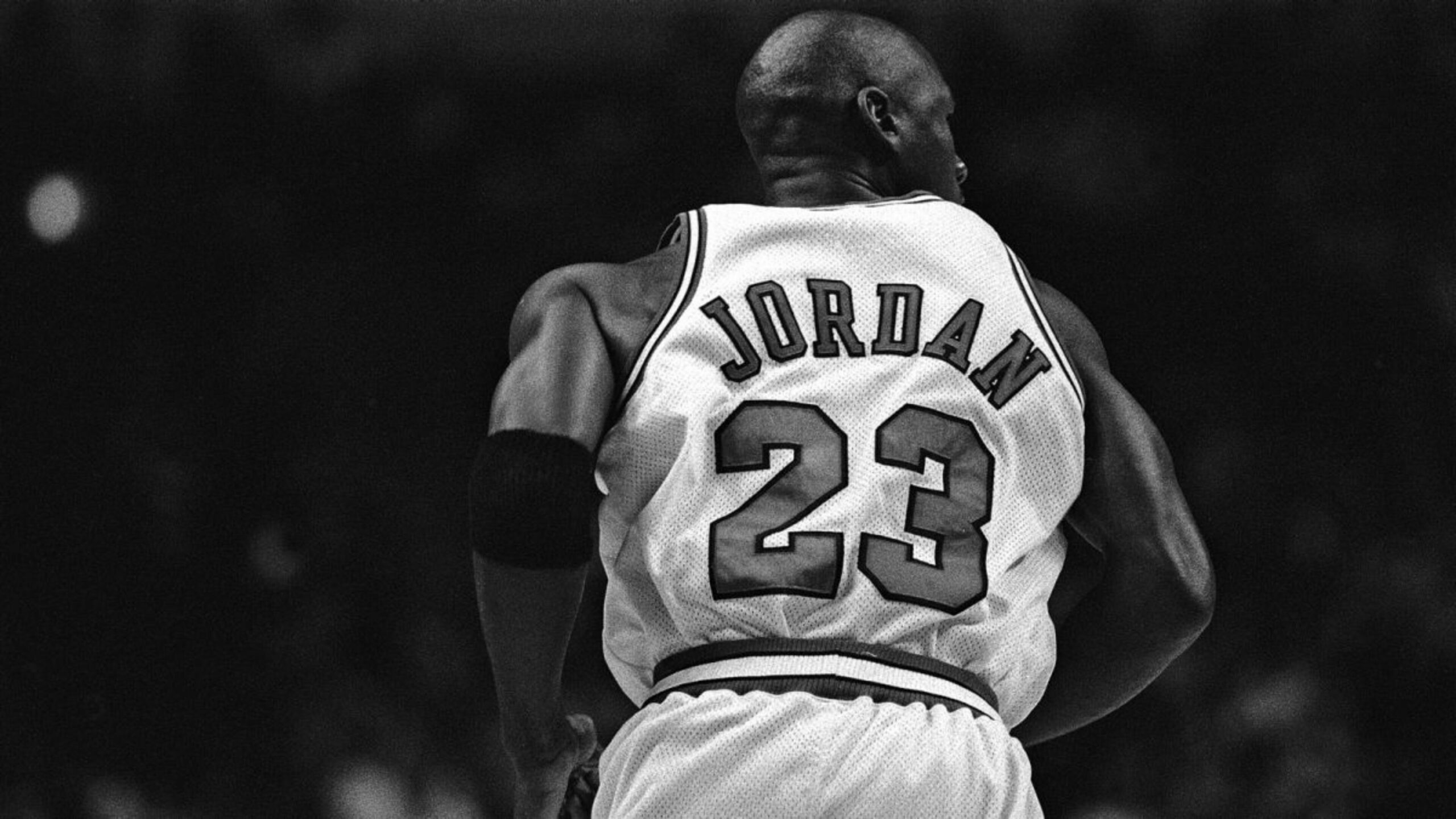In the pantheon of global sports, few figures command the awe, respect, and sheer reverence that surrounds Michael Jordan. More than just a basketball player, Jordan became a cultural icon, a marketing phenomenon, and the very embodiment of competitive excellence. His unparalleled dominance on the court, coupled with an almost mythical aura off it, elevated him beyond the realm of mere athleticism into a stratosphere reserved for true legends. His story is not just one of dunks and fadeaways, but of relentless pursuit of perfection, an unyielding will to win, and a transformative impact on sports and pop culture that continues to resonate decades after his final shot.
Humble Beginnings and the Spark of Greatness :
Born on February 17, 1963, in Brooklyn, New York, Michael Jeffrey Jordan’s family moved to Wilmington, North Carolina, shortly after his birth. His early life was marked by a loving, yet competitive, family environment. His father, James Jordan Sr., taught him the value of hard work, while his older brother, Larry, often served as a competitive benchmark, pushing Michael to strive for more. It’s a commonly cited anecdote that Michael, initially, didn’t make his high school varsity basketball team as a sophomore. This perceived snub, however, didn’t deter him; it fueled him. He used it as motivation, dedicating himself to improving his game, practicing relentlessly, and growing physically.
He ultimately made the varsity team as a junior and began to showcase the dazzling athleticism and competitive fire that would become his hallmarks. His senior year at Laney High School saw him average a triple-double, catching the attention of college scouts. Despite offers from several prominent programs, Jordan chose the University of North Carolina at Chapel Hill, playing under the legendary coach Dean Smith.
At UNC, Jordan’s talent blossomed. As a freshman, he famously hit the game-winning jump shot against Georgetown in the 1982 NCAA Championship game, a moment that instantly etched his name into college basketball lore. This clutch performance offered a tantalizing glimpse of the “clutch gene” that would define his professional career. During his three years at UNC, he refined his offensive skills, improved his defense, and began to understand the nuances of team basketball within a structured system. He was named the Naismith and Wooden College Player of the Year in 1984 before deciding to forgo his senior year and declare for the NBA draft.
The NBA Entry and the Birth of “Air Jordan” (1984-1990) :
Despite his collegiate success, Jordan was not the first pick in the 1984 NBA Draft. He was selected third overall by the Chicago Bulls, after Hakeem Olajuwon (Houston Rockets) and Sam Bowie (Portland Trail Blazers). This “snub” by the first two teams would become another chip on his shoulder, driving his competitive spirit.
From his rookie season, Jordan was a sensation. His acrobatic dunks, impossible hang-time, and relentless scoring immediately captivated audiences and earned him the nickname “Air Jordan.” He averaged 28.2 points per game, was named an All-Star starter in his first season, and won the Rookie of the Year award. However, the Bulls, a struggling franchise before his arrival, faced formidable challenges in the Eastern Conference, dominated by the Boston Celtics of Larry Bird and the Detroit Pistons, known as the “Bad Boys.”
For several years, Jordan’s individual brilliance was undeniable, but team success remained elusive. He consistently led the league in scoring, won Defensive Player of the Year, and delivered highlight-reel plays night after night. Yet, the Pistons, with their aggressive, physical defense known as the “Jordan Rules,” repeatedly thwarted the Bulls in the playoffs. These bitter playoff defeats, particularly in the late 1980s, were crucial in Jordan’s development. They instilled a deeper understanding of what it would take to win championships – not just individual brilliance, but strategic team play, mental toughness, and the ability to elevate teammates. He pushed himself to become stronger, to improve his passing, and to trust his teammates more.
The Dynasty Begins: The First Three-Peat (1991-1993) :
The turning point came with the maturation of the Bulls’ roster, particularly with the emergence of Scottie Pippen as an elite two-way player, and the tactical genius of coach Phil Jackson, who implemented the “triangle offense.” This system, which emphasized ball movement and player spacing, allowed Jordan’s brilliance to flourish within a cohesive team framework.
In 1991, the Bulls finally broke through, sweeping the Pistons in the Eastern Conference Finals and then defeating Magic Johnson’s Los Angeles Lakers in the NBA Finals. Jordan secured his first NBA championship and his first NBA Finals MVP award. This victory was famously emotional, as he clutched the championship trophy, tears in his eyes.
The Bulls didn’t stop there. They went on to win two more consecutive championships, defeating the Portland Trail Blazers in 1992 and Charles Barkley’s Phoenix Suns in 1993. Jordan was named Finals MVP in all three series, solidifying his status as the undisputed king of the league. He mastered the art of closing out games, delivering iconic clutch shots that became etched in basketball folklore. He averaged over 30 points per game in each of these championship seasons, showcasing an unmatched combination of scoring power, defensive intensity, and leadership.
The Shock Retirement and the Baseball Interlude (1993-1995) :
In October 1993, at the peak of his powers and after winning three consecutive NBA titles, Michael Jordan shocked the world by announcing his retirement from basketball. The decision was deeply influenced by the sudden and tragic murder of his father, James Jordan Sr., just months earlier. James had always dreamed of seeing his son play professional baseball, and Michael decided to pursue that dream in his father’s honor.
He signed a minor league contract with the Chicago White Sox and was assigned to their Double-A affiliate, the Birmingham Barons. While his baseball career was brief and statistically modest, averaging .202 with three home runs in 127 games in 1994, it showcased his unwavering dedication and willingness to challenge himself outside his comfort zone. It was a testament to his competitive spirit and a poignant tribute to his father.
However, the allure of basketball eventually proved too strong. After a stint with the Scottsdale Scorpions in the Arizona Fall League and with the NBA lockout looming in 1995, Jordan announced his return to the Chicago Bulls with the simple, iconic fax: “I’m back.”
The Second Three-Peat: Unfinished Business (1995-1998) :
Jordan’s return wasn’t immediately seamless, but by the 1995-96 season, he, Pippen, and a newly acquired Dennis Rodman formed an unstoppable force. The Bulls, under Phil Jackson, achieved an unprecedented 72-10 regular season record, a mark that stood for two decades. They went on to win the NBA championship, defeating the Seattle SuperSonics.
This marked the beginning of another dominant run. The Bulls completed their second “three-peat,” winning titles against the Utah Jazz in both 1997 and 1998. These final two championships were arguably the most dramatic, featuring epic battles against Karl Malone and John Stockton. Jordan delivered some of his most memorable moments, including “The Flu Game” in the 1997 Finals and “The Last Shot” over Bryon Russell in Game 6 of the 1998 Finals, a perfectly executed crossover and jumper that sealed his sixth championship and his sixth Finals MVP award. This was, by all accounts, the perfect ending to an extraordinary career with the Bulls. He retired for a second time in January 1999.
The Wizards Experiment and Final Retirement (2001-2003) :
After a three-year hiatus, Jordan made another surprising return to the NBA, this time as a player for the Washington Wizards from 2001 to 2003. While he showed flashes of his old brilliance, averaging over 20 points per game in both seasons and becoming the first 40-year-old to score 40 points in a game, the Wizards did not make the playoffs. This final chapter, while not adding to his championship tally, allowed a new generation of fans to witness his greatness and solidified his remarkable longevity. He retired for good after the 2002-2003 season.
The Unrivaled Legacy: More Than Just Stats :
Michael Jordan’s career statistics are staggering: 6 NBA championships, 6 NBA Finals MVP awards, 5 NBA MVP awards, 10 scoring titles, 9 All-Defensive First Team selections, 3 steals titles, and two Olympic gold medals (1984, 1992 Dream Team). He holds the highest career regular season scoring average (30.1 PPG) and playoff scoring average (33.4 PPG).
Michael Jordan’s career was a symphony of athletic grace, competitive ferocity, and unwavering resolve. He was a force of nature who elevated the game of basketball to an art form, consistently delivering moments of breathtaking brilliance. His flight, once confined to the hardwood courts, extended to the very fabric of global culture, making him not just a basketball legend, but an enduring symbol of human potential pushed to its absolute limit. His shadow looms large over the game, a perpetual reminder of what true greatness looks like.





Leave a Reply